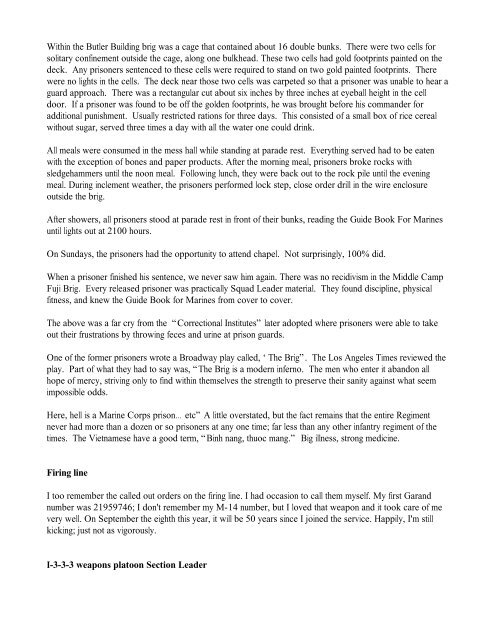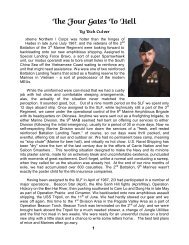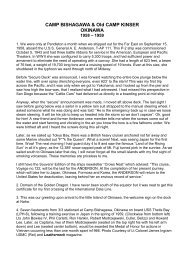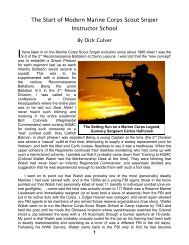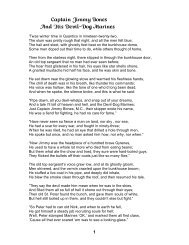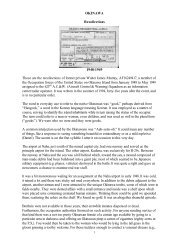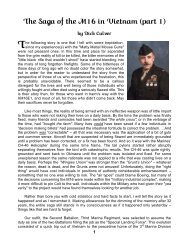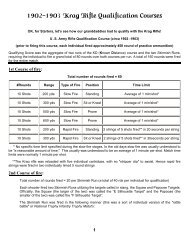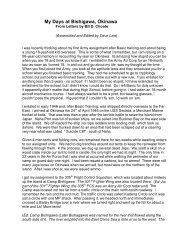Sea Stories" & Humor" - Rohrer, Bob Rohrer
Sea Stories" & Humor" - Rohrer, Bob Rohrer
Sea Stories" & Humor" - Rohrer, Bob Rohrer
You also want an ePaper? Increase the reach of your titles
YUMPU automatically turns print PDFs into web optimized ePapers that Google loves.
Within the Butler Building brig was a cage that contained about 16 double bunks. There were two cells for<br />
solitary confinement outside the cage, along one bulkhead. These two cells had gold footprints painted on the<br />
deck. Any prisoners sentenced to these cells were required to stand on two gold painted footprints. There<br />
were no lights in the cells. The deck near those two cells was carpeted so that a prisoner was unable to hear a<br />
guard approach. There was a rectangular cut about six inches by three inches at eyeball height in the cell<br />
door. If a prisoner was found to be off the golden footprints, he was brought before his commander for<br />
additional punishment. Usually restricted rations for three days. This consisted of a small box of rice cereal<br />
without sugar, served three times a day with all the water one could drink.<br />
All meals were consumed in the mess hall while standing at parade rest. Everything served had to be eaten<br />
with the exception of bones and paper products. After the morning meal, prisoners broke rocks with<br />
sledgehammers until the noon meal. Following lunch, they were back out to the rock pile until the evening<br />
meal. During inclement weather, the prisoners performed lock step, close order drill in the wire enclosure<br />
outside the brig.<br />
After showers, all prisoners stood at parade rest in front of their bunks, reading the Guide Book For Marines<br />
until lights out at 2100 hours.<br />
On Sundays, the prisoners had the opportunity to attend chapel. Not surprisingly, 100% did.<br />
When a prisoner finished his sentence, we never saw him again. There was no recidivism in the Middle Camp<br />
Fuji Brig. Every released prisoner was practically Squad Leader material. They found discipline, physical<br />
fitness, and knew the Guide Book for Marines from cover to cover.<br />
The above was a far cry from the “Correctional Institutes” later adopted where prisoners were able to take<br />
out their frustrations by throwing feces and urine at prison guards.<br />
One of the former prisoners wrote a Broadway play called, ‘The Brig”. The Los Angeles Times reviewed the<br />
play. Part of what they had to say was, “The Brig is a modern inferno. The men who enter it abandon all<br />
hope of mercy, striving only to find within themselves the strength to preserve their sanity against what seem<br />
impossible odds.<br />
Here, hell is a Marine Corps prison… etc” A little overstated, but the fact remains that the entire Regiment<br />
never had more than a dozen or so prisoners at any one time; far less than any other infantry regiment of the<br />
times. The Vietnamese have a good term, “Binh nang, thuoc mang.” Big illness, strong medicine.<br />
Firing line<br />
I too remember the called out orders on the firing line. I had occasion to call them myself. My first Garand<br />
number was 21959746; I don't remember my M-14 number, but I loved that weapon and it took care of me<br />
very well. On September the eighth this year, it will be 50 years since I joined the service. Happily, I'm still<br />
kicking; just not as vigorously.<br />
I-3-3-3 weapons platoon Section Leader


